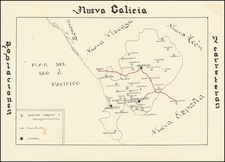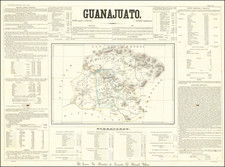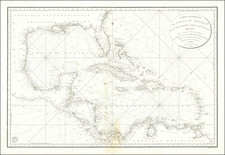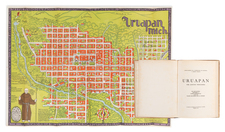Colorful Plan of Mexico City from an Era of Reform
This is a fine example of Manuel Villavicencio's map of Mexico City, dated December 12, 1782. It shows the attempts at urban reforms that characterized city management in the eighteenth century.
The map includes a decorative title cartouche that reads, "The noble city of Mexico divided in quarters under the order of the Exalted Viceroy Martin de Mayorga." The cartouche is surrounded by a scalloped frame and topped by a crowned lion that surveys the viewer regally. The coat of arms of what may be the Mayorga family is in the upper left corner, while a crowned eagle holds another coat of arms in the right top corner.
Mexico City sprawls before the viewer, revealing that while the neighborhoods are called quarters, there are far more than four of them. In fact, there are over thirty neighborhoods cordoned off from each other by red lines. The quarters are brightly colored in red, green, yellow, and blue on this east-oriented map. Churches are marked with crosses and the city's open spaces and even manicured gardens are evident.
Barbara Mundy argues that city plans like this reflect an attempt by officials to control urban space and, by extension, society. The map was a way to portray a more orderly city than actually existed. For example, as recently as 1779, a smallpox epidemic raged through the city, killing one fifth of the population. Hospitals could not hold the bodies and they filled the streets-a far cry from the order desired by city officials.
The city plan made the settlement seem controlled and calm, which in turn fed the reformist measures that were enacted in New Spain during the eighteenth century. City plans, including this one, were part of a governmental regime of presumed mastery of space, despite everyday occurrences that most likely blurred the cleanly separated colors of the plan.
The map appeared in a rare book, titled Ordenanza de la division de la nobilisima ciudad de Mexico en quarteles by Don Baltasar Ladrón de Guevara and approved by Viceroy Don Martín Díaz de Mayorga (hence the plan's dedication). The book's purpose was to layout the cities' political and geographic contours, "with the intention to eradicate violence, robbery, and delinquency". The book's explanation reveals the very messiness that the plan glosses over. Rather than see all the quarters as the same, as they appear on the map, the author explains that there are some places that are better referred to as slums, or arrabales.
The author says that the city was divided into eight districts (represented by the colors), with 32 sub-districts (represented by the red numbers). This division made policing easier and administration more manageable for unpaid officials.
The book's author, Baltasar Ladrón de Guevara, was a lawyer born in Guatemala City, Guatemala in 1725. He died in 1804. Little is known about the mapmaker, Manuel Villavicencio, although another man with the same name continued to produce maps in the nineteenth century-a descendent, perhaps.
More is known about the subject of the dedication, the Viceroy Mayorga. As a young man, Mayorga joined the Spanish army and he rose to the rank of field marshal. He was actually the interim Viceroy, stepping in when the position fell vacant upon the death of Antonio María de Bucareli y Ursúa. At the time, Mayorga had been serving as the governor of the Captaincy General of Guatemala. He was being replaced, but the replacement had not yet arrived, leaving Mayorga to take the promotion. After the 1779 smallpox epidemic, Mayorga offered his resignation, only to see the gesture rejected. He again offered his resignation in 1783, when it was accepted and he returned to Spain, dying just as he reached the Iberian Peninsula.
While in power, Mayorga led a campaign to improve the capital, of which the book and plan were a part. He oversaw the paving of many streets and made the waterways more sanitary-he actively tried to make the city resemble the tidy plan dedicated to him.
The map and book are quite rare. There are only a few examples of the book, with OCLC listing ten copies in US and Mexican libraries and at least one further copy in Spain.
Barbara Mundy, “The Images of Eighteenth-Century Urban Reform in Mexico City and the Plan of José Antonio Alzate,” Colonial Latin American Review 21, no. 1 (April 2012), pp. 45-75.
Ordenanza text: http://www.biblioteca.tv/artman2/publish/1782_374/Divisi_n_de_la_Ciudad_de_M_xico_en_cuarteles_Regla_1152.shtml
Manuel Villavicencio was born in Lima in 1840. He was the son of Manuel and Juana Villavisencio Freyre.
After completing his studies at the Colegio Peruano-Frances, Villvicencio entered the Naval Military Academy as midshipman on 1 August 1855, at the age of 13. After completing his studies, he graduated with the Class of Midshipman on July 29, 1857, and was assigned to the warship "Izcuchaca."
On March 30, 1858, Villavicencio was assigned to the frigate "Apurimac", with which he participated in the expedition to Ecuador between 1859 and 1860, where he participated in the blockade of Guayaquil, under the command of Admiral Ignatius Mariátegui. It was during this time period that he prepared his Carta Corografica de la Republica del Ecuador, published by Ferdinand Mayer & Co. in New York.
It would also appear that his grandfather (?), Manuel Villavicencio prepared a map of Santiago District of Mexico City in 1782.









![(Texas - Apache Depredations in Mexico) Discurso Que Pronunció el señor Coronel D. José Joaquin Calvo, Comandante general del Estado de Chihuahua, al entrar en ejercicio del Supremo Poder Ejecutivo del mismo [caption title]](https://storage.googleapis.com/raremaps/img/small/93111.jpg)




![[ Yucatan ] Karte der Halbinsel Yucatan, hauptsächlich nach der von Joachim Hubbe und Andres Aznar Perez zusammengestellten und von C. Hermann Berendt revidirten und vermehtren Mapa de la Peninsula de Yucatan von 1878](https://storage.googleapis.com/raremaps/img/small/96420.jpg)